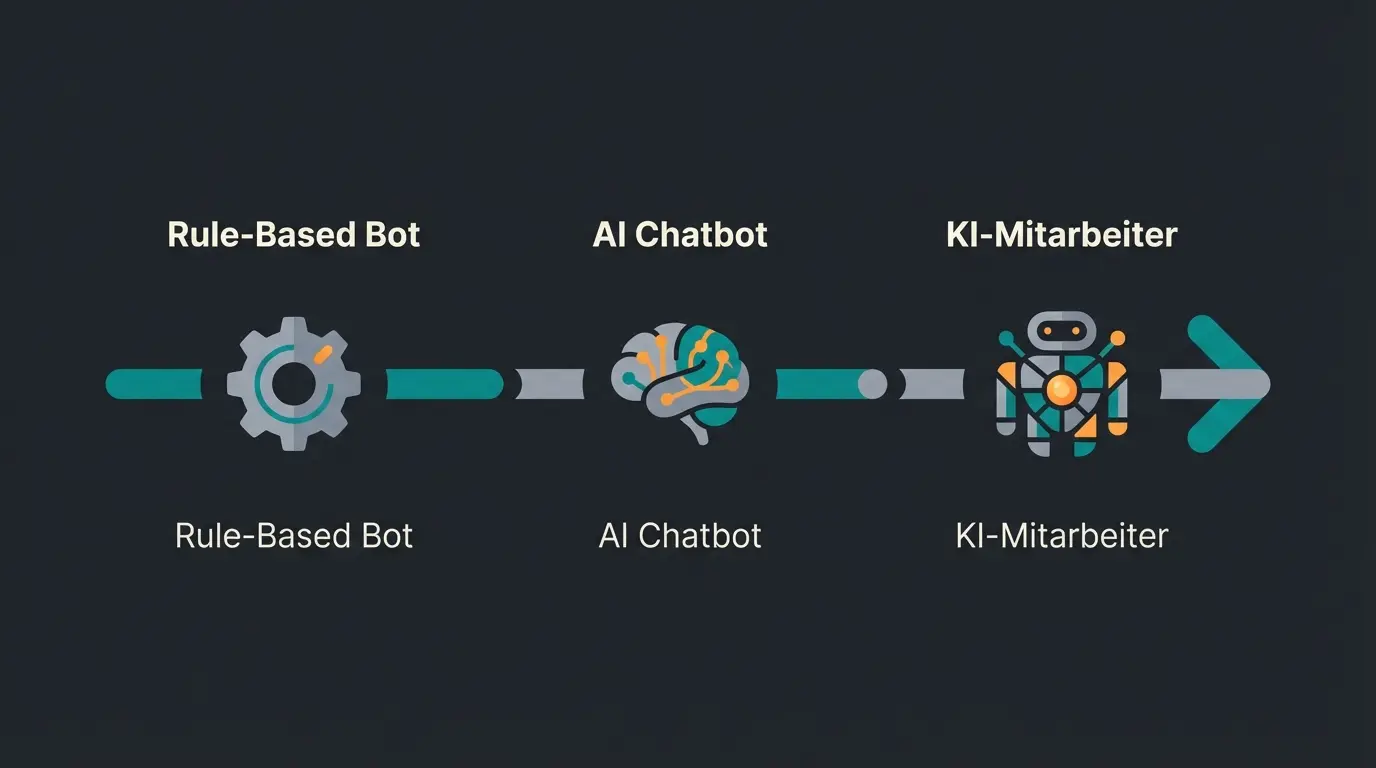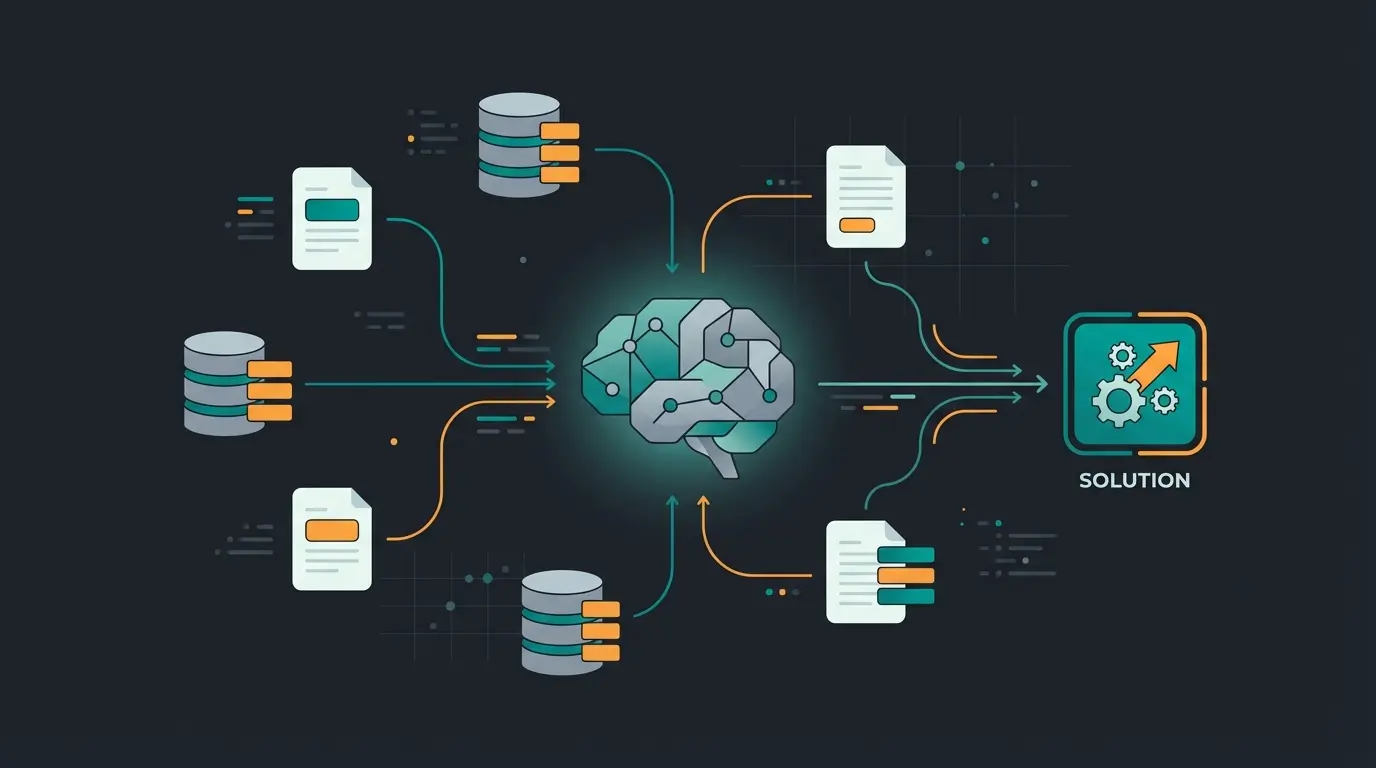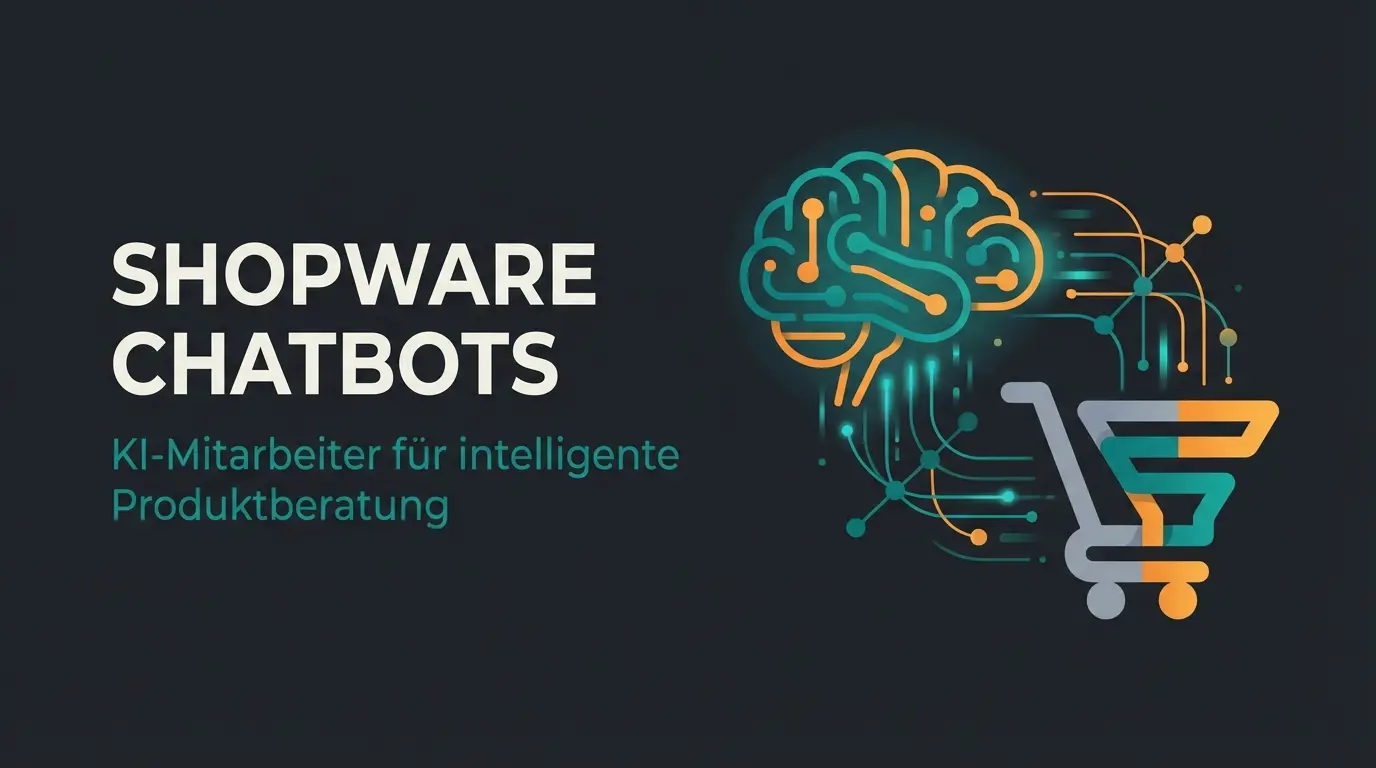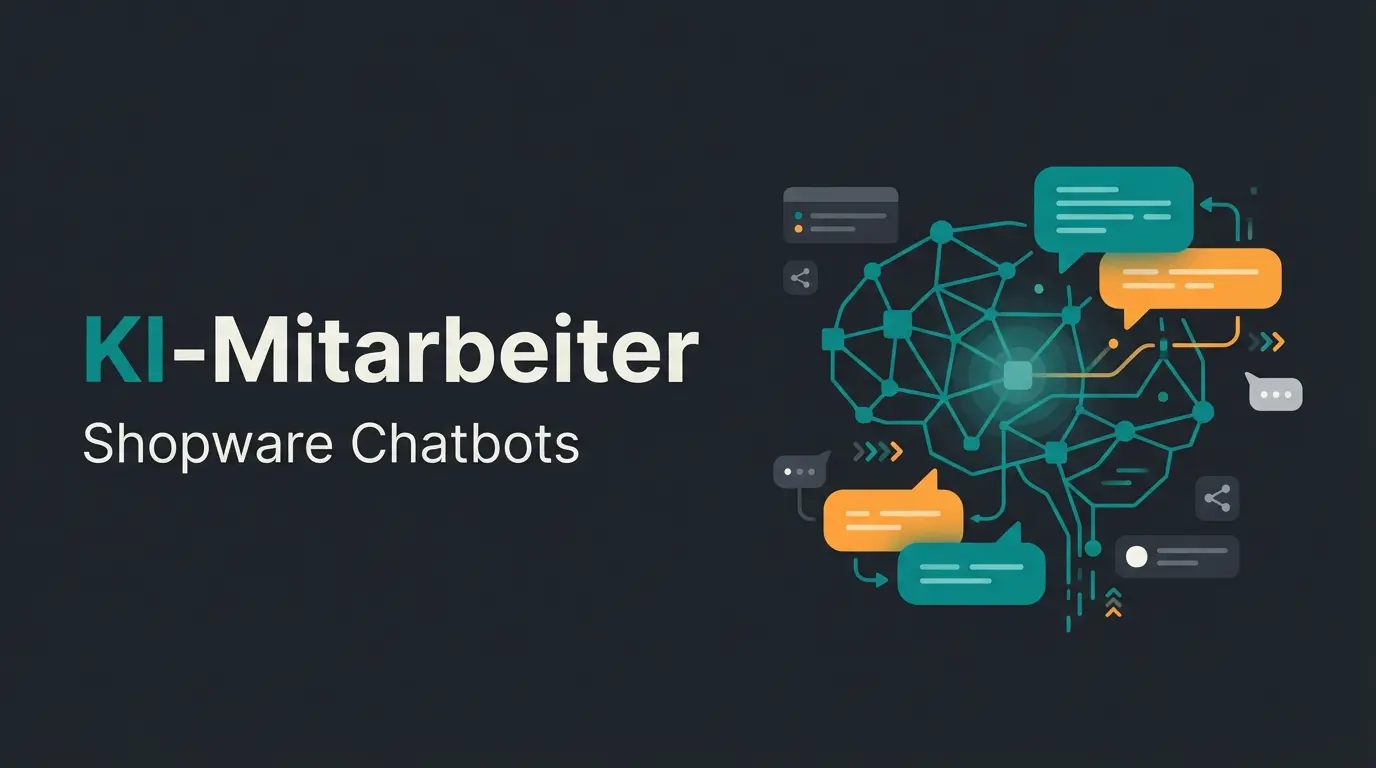KI-Mitarbeiter: More Than Just Chatbots – The Rise of Digital Expert Consultants
Discover how KI-Mitarbeiter (AI Agents) are evolving from simple chatbots into autonomous digital consultants that drive revenue and automate complex processes.
Digital transformation presents German companies, from SMEs to large corporations, with continuous new challenges. In this dynamic environment, automation in customer dialogue and underlying business processes is no longer an optional extra, but a critical success factor. Companies are looking for ways to become more efficient, reduce costs, and simultaneously improve the customer experience. However, especially when it comes to automating complex procedures, simple solutions quickly reach their limits. The market offers a plethora of technologies whose distinctions are often difficult to discern: from simple chatbots to intelligent dialogue systems and highly developed AI systems that act autonomously.
This technological development is not just an end in itself but reflects the growing demands of the business world. Initially, the focus was on increasing efficiency in repetitive tasks—here, simple chatbots were used to answer standard questions. With rising customer expectations for personalized and high-quality dialogues, AI-supported chatbots became relevant, understanding natural language better. Today, however, the trend goes further: companies strive for end-to-end automation of complex processes and proactive action, not only to offer service but to actively solve problems and increase revenue. This explains the rise of so-called KI-Mitarbeiter (AI Employees) or AI Agents.
This article aims to bring clarity to the terminology. It defines the three central categories—simple chatbots, AI chatbots, and KI-Mitarbeiter—analyzes their modes of operation as well as strengths and weaknesses, and offers a detailed comparison. This understanding is essential for companies to make strategically sound decisions about using the right automation technology, thereby sustainably increasing efficiency, customer satisfaction, and ultimately business success.
1. The Basis: What are Chatbots and How Do They Work?
A chatbot is fundamentally a computer program designed to simulate human conversation. The term is a combination of "Chat" (conversation) and "Bot" (short for robot). These text- or voice-based dialogue systems conduct automated conversations with users to provide information, answer questions, or perform simple tasks.
Their fundamental relevance for companies, particularly in the SME sector and corporations, often lies in serving as the first point of contact for customers. They can relieve customer service by answering frequently asked questions (FAQs) around the clock, for example regarding opening hours, product information, or delivery conditions. This 24/7 availability without human intervention is a significant advantage.
At the core, simpler variants are distinguished into two main types:
- Rule-based / Script-based Chatbots: These are the simplest form of chatbots. They function according to a fixed, predefined set of rules, often following a "If-Then logic." The conversation follows a rigid dialogue tree or script established in advance. Users frequently interact by selecting from given answer options or buttons. A typical example would be a bot that can exclusively answer questions about opening hours and must pass on any other inquiry. They are designed to follow a specific sequence, ranging from simple to complex, but always predefined.
- Keyword-based Chatbots: This type is a slight advancement. It analyzes the user's input for certain predefined keywords. If the bot recognizes a keyword known to it, it triggers a likewise predefined answer or action. For example, if a user asks: "Where can I find the delivery costs?", the bot recognizes the keyword "delivery costs" and outputs the stored standard information. Although somewhat more flexible than purely rule-based systems, their ability to understand the context or nuances of a question is still strictly limited.
Strengths of Simple Chatbots: The main advantage lies in their simplicity. They are comparatively easy to implement and maintain. Their answers are predictable and consistent, which is quite desirable in some use cases. For clearly defined, simple tasks, they are often the most cost-effective solution in terms of development and ongoing operation.
Weaknesses of Simple Chatbots: Simplicity is simultaneously their greatest weakness. Their flexibility is severely limited; they can only react to exactly the scenarios or keywords for which they were programmed. They possess no real language understanding and can neither grasp the context of a conversation nor learn from interactions. If a user asks an unexpected question or phrases it differently than intended, the bot quickly reaches its limits, cannot answer, and potentially causes frustration for the customer. Furthermore, all rules and answers must be manually created and updated as needed, which can be laborious with changing information.

2. Intelligence in Dialogue: KI-Chatbots Understand and Learn
The next stage of evolution is represented by AI-supported chatbots. These utilize Artificial Intelligence (AI) technologies to not only recognize human language but also to understand it and respond in a way that comes closer to a human-like conversation. The decisive difference from simple, rule-based systems lies in their ability to process natural language and learn from interactions. They are no longer rigidly bound to predefined scripts.
Key Technologies Explained:
Natural Language Processing (NLP): This is a field of AI that enables machines to understand and interpret human language—both written and spoken. NLP analyzes the structure, grammar, and meaning of sentences. It identifies keywords, recognizes the user's intent, and considers the context of the conversation. NLP comprises two essential sub-areas:
- Natural Language Understanding (NLU): Focuses on understanding the meaning and intent behind the user input. NLU converts unstructured human language into structured data that a machine can process. It is about understanding what the user actually means, not just what they say.
- Natural Language Generation (NLG): Takes care of generating human-like language as a response. Based on the processed information, NLG formulates a fitting and naturally sounding answer.
Machine Learning (ML): This technology gives KI-chatbots their ability to learn. Instead of being explicitly programmed for every possible question, ML models learn from large amounts of interaction data. They recognize patterns, understand relationships, and can independently improve their performance and the accuracy of their answers over time.
Through the use of NLP and ML, KI-Chatbots possess capabilities that go far beyond those of simple bots. They maintain context over multiple interactions, personalize responses based on user profiles, and handle vague intents with much higher accuracy.
3. The Next Level: KI-Mitarbeiter – Autonomous Agents for Complex Tasks
The evolution of automation technology leads us to the next level: the KI-Mitarbeiter. Also referred to as AI Agents, AI Workers, Digital Workers, or intelligent agents, these systems represent a significant leap over traditional chatbots, even the AI-supported ones. They are not primarily conceived as dialogue systems, but as advanced AI software that can act autonomously to achieve defined business goals.
The Crucial Difference: Acting Instead of Just Talking
Here lies the core distinction: While chatbots aim to provide information and conduct dialogues, KI-Mitarbeiter are designed to execute actions. They make independent decisions and can not only support but actively steer and automate complex, often cross-system business processes. They are aptly described as "action-activated AI-supported assistants", whose focus lies on goal-oriented task processing and problem-solving. They act more like "digital employees."
The "Brain" Behind the Agent: RAG & Emotional Intelligence
Unlike simple bots that rely on scripts, a KI-Mitarbeiter utilizes Retrieval-Augmented Generation (RAG). This allows the AI to access a vast, company-specific knowledge base in real-time—from technical manuals to current stock levels—to construct accurate, context-aware answers. It doesn't just recite text; it "thinks" about the best solution.
Furthermore, these agents are equipped with Emotional Intelligence. They can detect the tone of voice and sentiment of a customer. If a customer is frustrated, the KI-Mitarbeiter switches from a factual tone to an empathetic, de-escalating style, a nuance crucial for high-value consultation.

4. Chatbots vs. KI-Mitarbeiter: The Definitive Comparison
To develop the right automation strategy, a clear distinction between the technologies is essential. The following table highlights the critical differences between a standard chatbot, an AI chatbot, and a fully autonomous KI-Mitarbeiter.
| Feature | Rule-Based Chatbot | KI-Chatbot | KI-Mitarbeiter (Agent) |
|---|---|---|---|
| Primary Goal | Answer simple FAQs | Simulate conversation | Execute actions & solve problems |
| Technology | If-Then Scripts | NLP & Machine Learning | LLMs, RAG, API Integrations |
| Autonomy | None (Reactive) | Low (Dialog focused) | High (Proactive decision making) |
| Context | None | Conversation history | Full business & user context |
| Capabilities | Provide text info | Understand intent | Perform complex workflows (e.g. Refunds) |
Why Future Customer Service is "Consultation" not "Support"
Most businesses view automation as a way to cut costs in the support department. This is a limited view. The true power of a KI-Mitarbeiter lies in its ability to act as a Digital Expert Consultant.
While a support bot answers "Where is my package?", a digital consultant answers "Which package fits my budget and needs?". This shifts the interaction from a cost center to a revenue generator. The AI can guide a user through a complex purchase decision—configuring a car, choosing the right software plan, or finding the perfect skincare product—with the expertise of your best sales representative, available 24/7.
AI detects not just keywords, but the user's underlying need and emotional state.
Using RAG, the AI pulls specific product details and availability from the database.
The Agent decides on the best sales approach: upsell, educate, or troubleshoot.
The AI completes the transaction, books the appointment, or updates the CRM autonomously.
Don't just settle for a chatbot. Deploy a KI-Mitarbeiter that acts, sells, and solves problems autonomously.
Start Your Transformation5. Intelligent Automation in Practice: How Qualimero Uses KI-Mitarbeiter
After clarifying the differences, the question arises: What does this look like in the real world? Qualimero specializes in exactly this area, offering solutions that go beyond mere dialogue to deliver measurable business results.
Qualimero's Approach: The focus is on achieving outcomes like revenue growth and cost reduction. The AI employees act with human-like intelligence, supported by a "Done-for-You" service approach that integrates seamlessly into specific workflows.
- [KI-Produktberater im E-Commerce](/blog/ai-chatbots-conversational-commerce): This digital employee interacts with customers on websites or WhatsApp. It analyzes needs in real-time, recommends products, and even initiates returns. One client reported a 95% reduction in sales inquiries forwarded to humans.
- [Lead-Qualifizierung im Vertrieb](/leadgen-via-ai): The KI-Mitarbeiter conducts qualifying conversations, collects relevant information, and books appointments directly into sales calendars. Qualimero notes a 10x higher conversion rate compared to traditional forms.
Example: A Digital Sales Conversation
Here is how a KI-Mitarbeiter handles a vague customer request, turning it into a sale through active consultation:
Increase in overall customer service efficiency.
Percentage of support queries answered immediately by AI.
Higher conversion in lead qualification vs. forms.
6. Outlook & Data Privacy: The Future Belongs to Acting AI
The trend is clear: the future belongs to systems that act. The shift from pure conversation partners to proactive problem solvers enables companies to automate end-to-end business processes. For the German market, however, one aspect remains paramount: Data Privacy and GDPR (Datenschutz).
German searchers and companies are rightly skeptical about data handling. A robust KI-Mitarbeiter solution must be fully GDPR-compliant. This involves hosting data on secure servers (ideally within the EU), anonymizing personal data where possible, and ensuring transparency about AI interactions. Qualimero emphasizes this security aspect, ensuring that the efficiency of AI does not come at the cost of data sovereignty. The successful introduction of these agents requires a holistic strategy that considers technology, processes, and strict compliance equally.
7. Conclusion
The journey of automation has reached a transformative stage. KI-Mitarbeiter are not just advanced chatbots; they are digital colleagues that act proactively, learn from experience, and integrate deeply into your systems. This offers companies—from agile SMEs to established corporations—the chance to elevate efficiency and customer experience to a new level.
Are you ready to fully exploit the potential of intelligent automation for your company? Discover how Qualimero's customized KI-Mitarbeiter can optimize your processes, relieve your team, and delight your customers.
A chatbot primarily answers questions based on scripts or simple AI. A KI-Mitarbeiter (AI Agent) acts autonomously to execute complex tasks, solve problems, and trigger actions in other systems like CRMs or booking tools.
Yes, reputable providers like Qualimero ensure full GDPR compliance by hosting data securely and adhering to strict European data protection standards.
They are designed to augment your team, not strictly replace it. They handle repetitive and scalable tasks (up to 80% of volume), allowing human employees to focus on high-value, strategic, and emotional tasks.
Unlike traditional software projects taking months, modern 'Done-for-You' solutions can often go live within a few days, as they are pre-trained on industry-specific scenarios.
Transform your customer service and sales with intelligent KI-Mitarbeiter. Get your free consultation today.
Book a Demo


